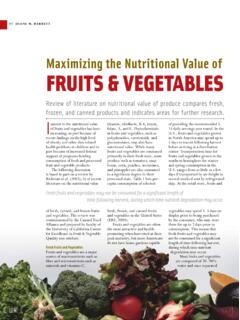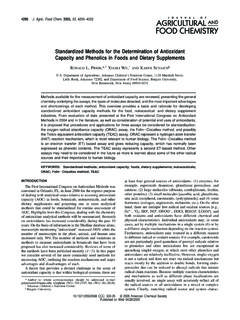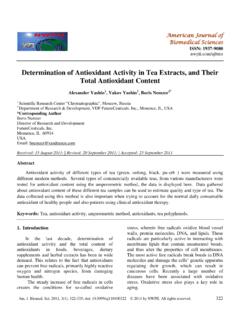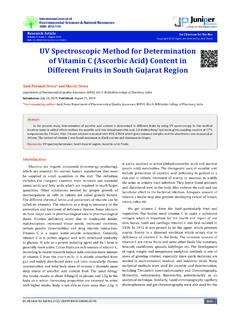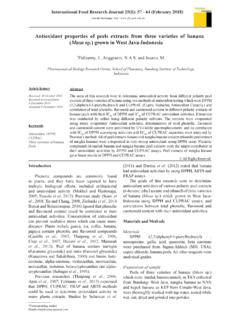Transcription of Potential of Calamansi (Citrofortunella microcarpa) Fruit ...
1 29 Potential of Calamansi ( citrofortunella microcarpa ) Fruit Peels Extract in Lowering the Blood Glucose Level of Streptozotocin Induced Albino Rats (Rattus albus) Maria Ysabel T. Morte San Beda College, Manila, Philippines Email: Liwayway H. Acero, Department of Natural Sciences, San Beda College, Manila, Philippines Email: Abstract Calamansi or calamondin is very abundant and one of the sources of staple Fruit juice in the Philippines. It is grown principally for its Fruit juice, since it is widely known as good source of Vitamin C.
2 However, the peels are thrown after the extraction of the juice. The medicinal use of the peel was still unknown to many Filipinos, thus this study focuses on the Potential of Calamansi peels in lowering blood sugar in streptozotocin induced Albino rats. Calamansi peels were dried, macerated, and the filtrate was subjected to rotary evaporator. The extract were diluted with distilled water and administered orally in Albino rats. Twenty Albino rats served as experimental animals. They are randomly assigned in two groups. The first group, or treatment 1, (10 animals) as the control wherein they only fed with rat pellets and drinking water.
3 The second group-treatment 2 served as the experimental animals where Calamansi peel extract solution was administered orally for the entire duration of the study. Baseline blood glucose, fasting blood sugar before Stretozotocin (STZ) induction and blood sugar after three days STZ induction of both treatments showed no significant result. Final blood sugar after five days of administration of the Calamansi peel extract solution showed significant result. The result revealed that Calamansi peel extract solution has the Potential for lowering blood glucose in Albino Rats.
4 This implies that Calamansi peel extract solution could be used as herbal medicine to lower blood glucose. Index Terms Calamansi , Calamondin, streptozotocin, blood glucose I. INTRODUCTION Calamondin ( citrofortunella microcarpa ) fruits or locally known as Kalamansi is widely cultivated in Philippines and is used as a condiment almost in every famous dish made in the Philippines. Only the pulp were squeezed and is needed, the peels are just thrown away. It belongs to the family Rutaceae. It is an intergenetic hybrid between a member of Citrus reticulata or tangerine and kumquat or Fortunella japonica.
5 The Calamansi tree has Manuscript received October 14, 2016; revised April 30, 2017. a height of 3 to 5 meters high, and is erect, slender, densely branched close to the ground, slightly spiny, and bears broad-oval, dark green leaves on the surface, yellowish beneath, sweetly fragrant white flowers with 5 elliptic-oblong petals, and fruits that are round that is about cm wide with very thin, aromatic peel with visible pores. The pulp have 6 to 10 segments that is colored yellow to orange, very juicy, seedless or with 1 to 5 small ovoid green seeds within.
6 It has been known not only for its refreshing juices and flavors, but also for its medicinal uses. Calamansi Fruit may be crushed and use to shampoo in hair or may be applied into scalp after shampooing for hair growth and relief of itching. Calamondin juice may be also applied and rubbed on mosquito bites to eliminate irritation and itching. It also bleaches freckles and clear up acne vulgaris if applied regularly. Juice is also taken orally as a cough remedy and is sometimes combined with pepper, to expel phlegm. It can also be diluted and drunk warm as a fecal softener.
7 Distilled oil of the leaves can act as a carminative for having a volatile oil content of to [1]. Research found that the leaves of the evergreen shrub of kumquat (Fortunella japonica) which is common in China, and belongs to the same family Rutaceae with Calamondin ( citrofortunella microcarpa ) has hypolipidemic, hypoglycemic, and antioxidative effects [2]. Calamansi is richly cultivated in the Philippines, its average annual per capita consumption is as waste [3]. Citrus fruits such as Calamansi , is utilized mainly for its pulp and juice, the rest of the Fruit or the pressed pulp, covering of pulp segment, seeds, and the rind are considered largest source of citrus waste, finding a way to utilize it will also help the environment.
8 Since Calamansi belongs to citrus family it can now be utilized as source of herbal medicine. If its Potential use as herbal medicine is explored it can also help in the reduction of environmental pollution. Diabetes mellitus incidences increases daily and it is one of the top ten causes of death. In 2008, a survey was International Journal of Food Engineering Vol. 3, No. 1, June 2017 2017 International Journal of Food Engineeringdoi: 30 conducted and showed that one in every five Filipino has diabetes.
9 This only means 20% of the total population has diabetes. Although it has only increased 4% since 1998, these numbers still cause alarm since Filipinos diagnosed with diabetes are reported to be younger and younger [4]. In 2010, there were 285 million people worldwide diagnosed with diabetes. It is estimated to rise over 50% and incidence to increase to 438 million by 2030. Estimated 80% of diabetics live in developing countries [5]. With Calamansi , being common, well propagated, and has not been studied in Philippine setting with its hypoglycemic Potential , hence this study.
10 The result of the research will be useful to people who are prone to have diabetes mellitus, which in today s stressful lifestyle makes everyone at risk. This study determines the baseline blood glucose, fasting blood glucose before streptozotocin induction, blood glucose on the third day after induction of streptozotocin and final blood glucose level after five days Calamansi peel extract administration Likewise the difference on blood glucose of the experimental group before and after Calamansi peel extract administration was also evaluated.

